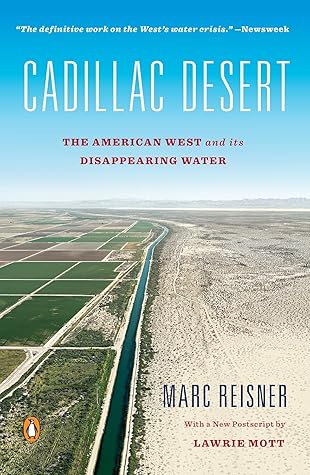More on this book
Community
Kindle Notes & Highlights
by
Marc Reisner
Read between
September 1 - October 14, 2019
California has twelve hundred major dams, the two biggest irrigation projects on earth, and more irrigated acreage than any other state, but its irrigated acreage is not much larger than Vermont.
To easterners, “conservation” of water usually means protecting rivers from development; in the West, it means building dams.
Mulholland preached soil and forest conservation thirty years before its time. He wanted to seed the whole basin, and when he said that the deforestation of the mountainsides would reduce the basin’s water supply, everyone thought he was slightly nuts.
The Westinghouse generators built for Grand Coulee were rated for a maximum output of 105,000 kilowatts each, which was the capacity of a good-sized oil power plant that could run, say, Duluth. For the entire duration of the war, they ran at 125,000 kilowatts, twenty-four hours a day, without a glitch.
He called it a “willful and expensive . . . self-serving clique . . . in contempt of the public welfare” which had the distinction of having “wantonly wasted money on worthless projects” to a degree “surpassing any federal agency in the history of this country. . . . [N]o more lawless or irresponsible group than the Corps of Army Engineers,” Ickes concluded, “has ever attempted to operate in the United States either outside of or within the law. . . . It is truly beyond imagination.”
These farmers were about the most conservative faction in what may be the most politically conservative of all the fifty states. They regularly sent to Congress politicians eager to demolish the social edifice built by the New Deal—to abolish welfare, school lunch programs, aid to the handicapped, funding for the arts, even to sell off some of the national parks and public lands. But their constituents had become the ultimate example of what they decried, so coddled by the government that they lived in the cocoonlike world of a child.
All the while I’m trying to raise a thousand acres of corn and worry about a few hundred head of cattle. It was no picnic, I’ll tell you. One thing about the Bureau, though,” Christenson added grimly: “They sure know how to make a person mad.”
It wasn’t the vision and principles of our forefathers that made this country great. It was the huge unused bonanza they found here. One wave of immigrants after another could occupy new land, new land, new land. There was topsoil, water—there was gold, silver, and iron ore lying right on top of the earth. We picked our way through a ripe orchard and made it bare. The new generations are going to go down, down, down.
When a $1 million home perched on a fifty-degree slope above Malibu is clobbered by a mudslide after three weeks of rain—as thousands of houses throughout California were during the El Niño winters of 1982 and 1983—their owners tend to think of themselves as the victims of a “natural” disaster.
The Sanmexia Reservoir in China, an extreme case, was completed in 1960 and already decommissioned by 1964; it had silted up completely. The Tehri Dam in India, the sixth-highest in the world, recently saw its projected useful life reduced from one hundred to thirty years due to horrific deforestation in the Himalaya foothills. In the Dominican Republic, the eighty-thousand-kilowatt Tavera Hydroelectric Project, the country’s largest, was completed in 1973; by 1984, silt behind the dam had reached a depth of eighteen meters and storage capacity had been reduced by 40 percent.
For thousands of years Egyptian farmers irrigated by simple diversions from the Nile and nothing went badly wrong; then Egypt built the Aswan High Dam and got waterlogged land, salinity, schistosomiasis, nutrient-starved fields, a dying Mediterranean fishery, and a bill for all of the above that will easily eclipse the value of the irrigation “miracle” wrought by the dam. In the American West, the Bureau and the Corps fostered a similar style of water development that, though amazingly fruitful in the short run, leaves everyone and everything more vulnerable in the end.
The effect of everything, according to the economists, is that a few thousand farmers will, over the course of fifty years, receive a billion and a half dollars’ worth of taxpayer generosity that was never supposed to be theirs. (The value of the interest exemption isn’t included in this figure; that was their right.) And the result, according to the NRDC, is that
Spread across the district, the subsidy to Westlands amounts to something like $217 per acre per year; the average annual revenue produced by an acre of Westlands land is only $290.
The Bureau of Reclamation set out to help the small farmers of the West but ended up making a lot of rich farmers even wealthier at the small farmers’ expense. Through water development, the federal government set out to rescue farmers from natural hardships—droughts and floods—but created a new kind of hardship in the form of a chronic, seemingly permanent condition of agricultural glut. We set out to tame the rivers and ended up killing them. We set out to make the future of the American West secure; what we really did was make ourselves rich and our descendants insecure. Few of them are apt
...more
Earthquakes are quite harmless until you decide to put millions of people and two trillion dollars in real estate atop scissile fault zones.
You need seven or eight feet of water in the hot deserts to keep grass alive, which means that you need almost fifty thousand pounds of water to raise one pound of cow.
California has a shortage of water because it has a surfeit of cows—it’s really almost as simple as that.


